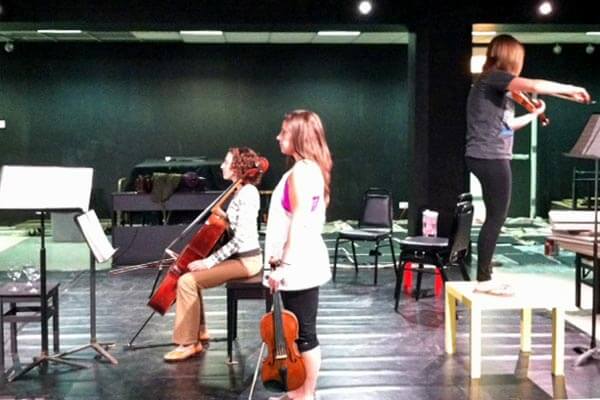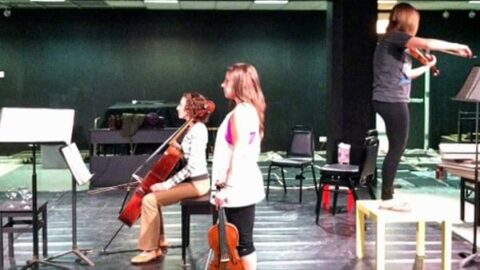The composition of Chicago Q Ensemble has recently morphed from a string quartet to a string trio. Violinist Ellen McSweeney (who is also a must-follow writer for NewMusicBox and other sites) and her bandmates, cellist Sara Sitzer and violist Aimee Biasiello, are launching their 2013-14 season with an ambitious new theatrical show called THREE-SIDED. Ellen kindly obliged to tell us what they have planned.
Tell us about your new production THREE-SIDED. What are you going to be doing besides playing your instruments? How did the concept come about and what are the unique challenges?
THREE-SIDED combines chamber music performance and theatrical production, and we will be blurring the lines between those two concepts throughout the show. Our idea was to create something completely seamless from beginning to end, and by doing so, connecting three incredibly different pieces by Marcos Balter, Ludwig van Beethoven, and Andrew Norman, woven together by new sound art composed by Jenna Lyle. Unlike traditional chamber music concerts, where the performers disappear into the music itself, our roles will be as “characters” within the production, and we have incorporated staging, lighting, and set design to compliment and enhance the musical works. This concept really took shape when we first met with Deirdre Harrison, our staging collaborator for the show. What started as an idea to include some sort of text or storytelling in between pieces in a traditional concert format eventually morphed into something that uses movement in lieu of words to express each of the three of our own personal journeys that have brought us to this moment in time, both personally and as an ensemble.

The centerpiece will be Andrew Norman’s A Companion Guide to Rome. How does that work lend itself to your concept? What obstacles have you encountered in adapting it and how are you addressing them?
Not only is A Companion Guide to Rome our centerpiece, it was our starting point and our source of inspiration for developing the rest of the show. Each of the nine movements evoke a different church in Rome, but, as Andrew writes in his notes, the movements are more an embodiment of the patron saints of those churches, not the structures themselves. In preparing for the show, we researched the personalities and stories of these famous saints, and with Deirdre’s help, are using movement and staging to bring them to life as we perform the piece. Andrew actually included some staging notes in the score, and when we emailed him for his permission to add more, he was all for it! One of the most challenging obstacles we’ve encountered is the fact that by creating this kind of performance, we’ve realized that we can’t get away with leaving any single detail to chance. This goes for our clothing, the way we remove our bows from the strings at the end of a piece, or the way our facial expressions look while we aren’t playing. As if musical rehearsals didn’t take enough time and energy when preparing for a performance, we have found that all the other details are almost more important in this case.
You will also play works from local Chicago-based composers Marcos Balter and Jenna Lyle. How do these pieces fit into the program?
We love Marcos’ Vision Mantra and performed it a few times last season. It’s a beautifully atmospheric piece that encourages the listener to pay attention to every detail. For THREE-SIDED, it’s first on the program and serves as a kind of entr’acte, which we think will help both performers and audience enter a meditative space. Jenna’s contribution to the show is a set of three short electronic sound pieces, one of which will be a prelude and two of which will serve as transitions between pieces. Jenna’s music is so imaginative, so alive and breathing. We felt that her voice would be an important part of a show which, at the end of the day, is about three living, breathing bodies onstage.
THREE-SIDED will be presented at Constellation Chicago on Peter Margasak’s Frequency Series. Tell us about working with Peter and Constellation. How are these new presentation opportunities changing the landscape for contemporary music in Chicago?
Peter has done such a tremendous job programming the Frequency Series. In just a few months, the series has essentially turned Constellation into a Sunday night who’s-who of contemporary chamber music in Chicago. And everything else happening at Constellation is also really exciting, including major national and international artists. It’s a venue that’s fully equipped to help us execute our vision of a theatrical performance, so we’re really grateful for the chance to be there.
Violist Aimee Biasiello is coming back after a long layoff with a shoulder injury and violinist Kate Carter has left the group to concentrate on solo projects. What does the future hold for Chicago Q Ensemble?
We plan to forge ahead as a trio and continue taking risks and exploring new creative territory. Working on THREE-SIDED has engaged us as whole human beings in a way that is unprecedented for us in our chamber music careers. We want to learn more about theater, about movement, about storytelling and improvisation. We’re ready to build our artistic toolkit so that we can keep creating shows that feel artistically whole.
























